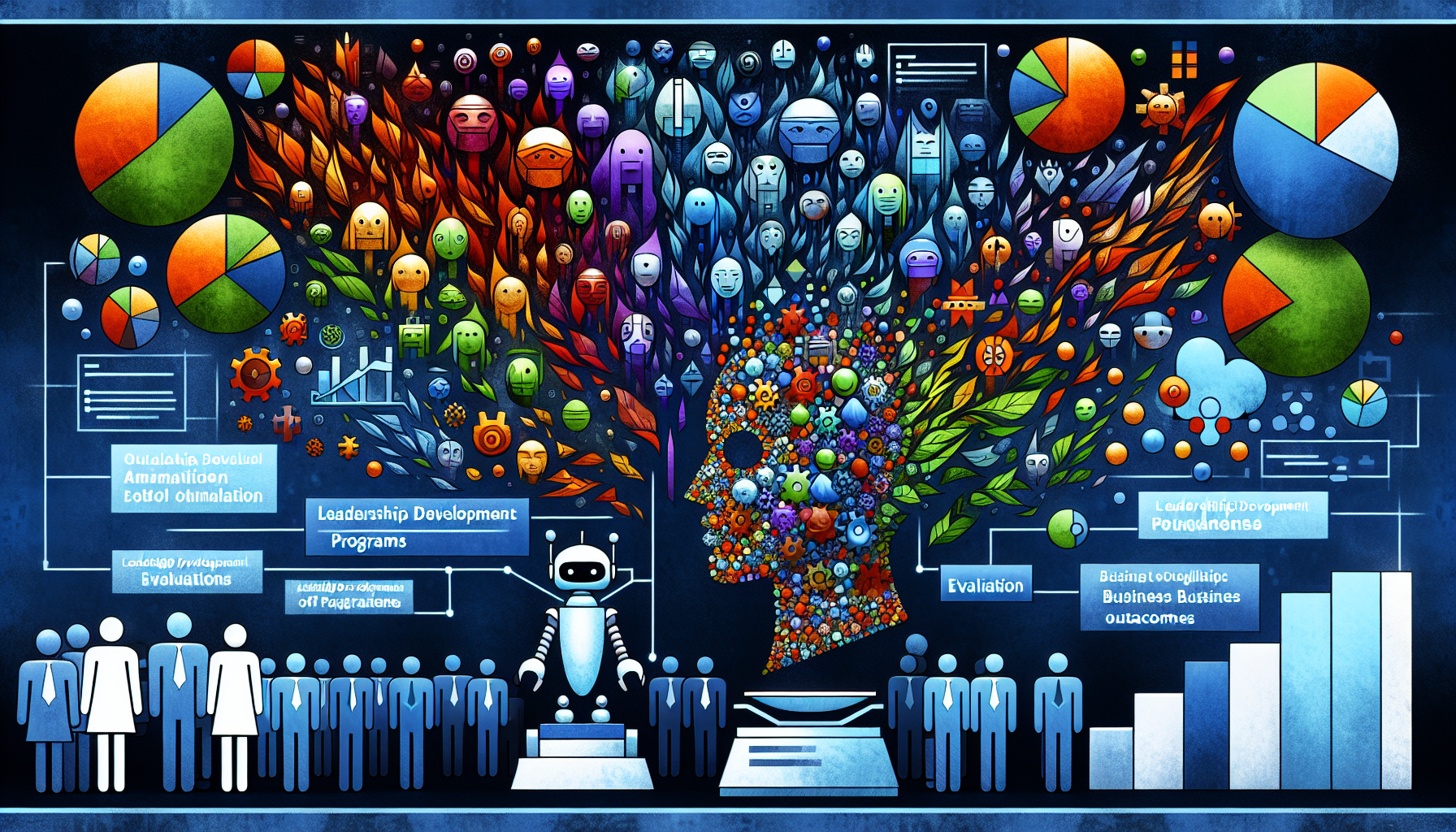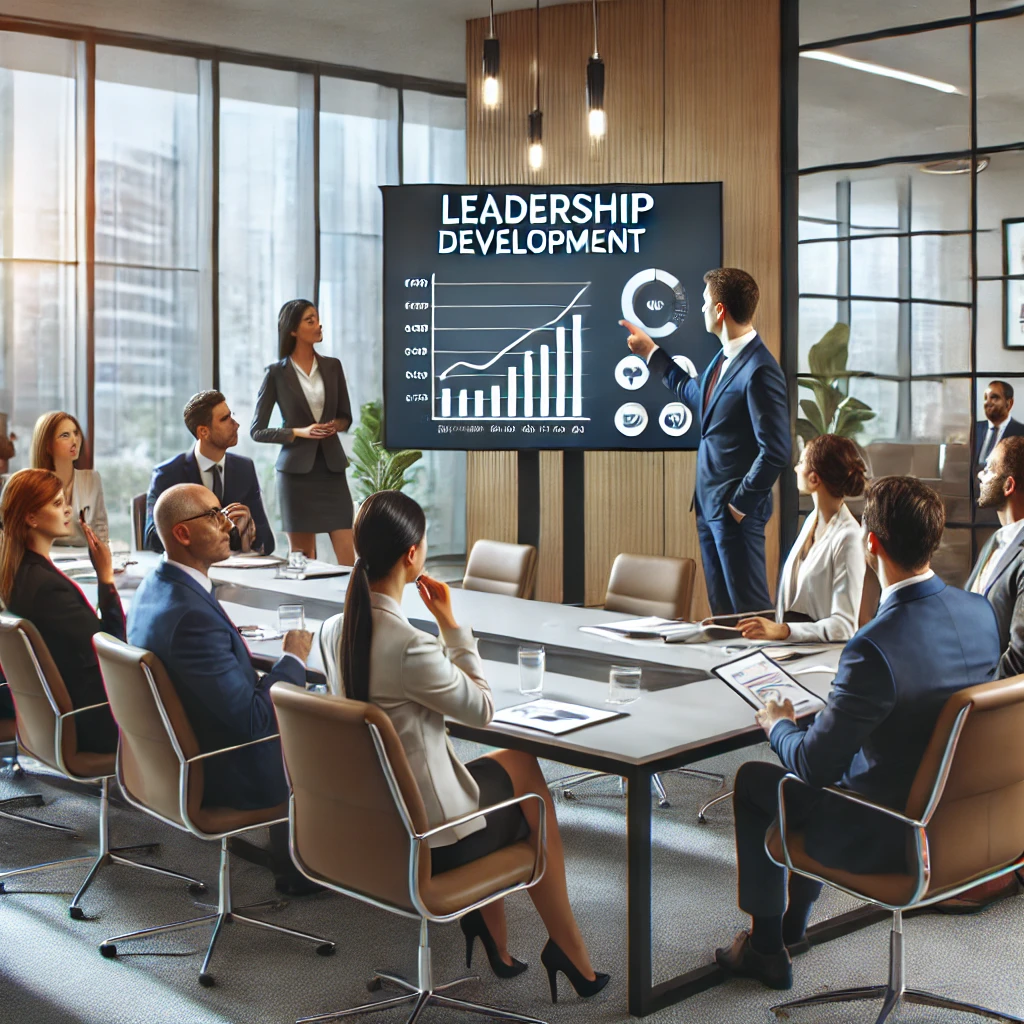5 Best Practices for Leadership for Development Success
Want to develop stronger leaders within your organization? In this article, discover best practices for leadership for development. We’ll explore how identifying and developing one’s leadership style is a key aspect of leadership for development, along with identifying critical competencies, designing personalized learning programs, and applying continuous assessment, ensuring your leadership pipeline is robust and aligned with your business objectives.
Key Takeaways
- A multifaceted and structured approach is crucial for effective leadership development, emphasizing early skills development, business continuity, and competitive advantage.
- Effective leadership development programs include identifying critical leadership competencies, designing customized learning experiences, and ensuring continuous assessment and feedback.
- Measuring the impact of leadership development programs through qualitative and quantitative metrics, feedback from participants, and analysis of business outcomes is essential for continuous improvement and alignment with organizational goals.
Ready to transform your leadership style and take your business to the next level?
Book a 15-minute discovery call with me now, and let’s discuss how we can achieve your goals together. Click here to schedule your session: Schedule a Call
Understanding Leadership for Development

Leadership development is a multifaceted process that prepares individuals for current and future leadership roles. It encompasses a range of activities designed to enhance leadership skills and abilities, ensuring that leaders are well-equipped to navigate complex organizational challenges. Understanding and developing one’s leadership style is crucial in this context, as it allows leaders to be agile and adaptable in various situations. Leadership development includes a solid leadership development plan, which is essential for the continuous growth and evolution of an organization’s leadership, aligning with business priorities and driving overall success.
A structured approach is crucial to prevent other priorities from overshadowing the critical task of leadership development.
Defining Leadership for Development
Leadership for development is about creating future leaders through structured programs and initiatives. Unlike the rigid pathways of the past, the leadership development journey is now more fluid, allowing for adaptation and growth.
Developing a flexible leadership style is essential for adapting to the fluid nature of modern leadership development.
Early development of leadership skills enables individuals to maximize their potential and make significant long-term contributions. This proactive approach benefits the individual and strengthens the leadership pipeline within the organization.
The Importance of Leadership Development
Leadership development is crucial for business continuity and competitive advantage. Strong leaders provide stability and direction in times of crisis and market shifts, keeping valuable employees engaged and motivated. Enhanced management capabilities and better decision-making are direct outcomes of robust leadership development programs.
Moreover, well-trained leaders contribute to improved employee morale, fostering a positive and productive work environment. The growing emphasis on leadership development is reflected in the fact that 60% of HR executives prioritize cultivating leader effectiveness.
Are you committed to enhancing your leadership capabilities for lasting success?
Don’t miss out on the opportunity to get personalized guidance. Book your 15-minute call with me today to learn more about our leadership development programs. Book Your Call
Key Components of an Effective Leadership Development Program

An effective leadership development program is built on three key components: identifying critical leadership competencies, designing customized learning experiences, and ensuring continuous assessment and feedback. These elements align the program with business priorities, deliver impactful learning experiences, and integrate real-life practice to reinforce learning. Customized learning experiences should consider each individual’s unique leadership style, ensuring that the program is both immersive and transformative. Organizations focusing on these areas can develop one of the best leadership development programs that enhance individual capabilities while driving overall business performance.
Transformative leadership is within your reach.
If you’re ready to tailor your development with expert guidance, schedule a call with me. Together, we’ll craft a path to your success. Start Here
Identifying Critical Leadership Competencies
Identifying and developing critical leadership competencies is essential for a successful leadership development plan. Competencies such as emotional intelligence, self-management, and conflict management are foundational for effective leadership. Organizations often use leadership competency frameworks to pinpoint these key skills and address gaps through targeted developmental opportunities.
Focusing on these leadership abilities equips effective leaders to meet challenges and navigate future crises.
Designing Customized Learning Experiences

Customized learning experiences are vital for addressing the unique needs of each leader. Methods such as:
- Job shadowing
- Peer mentoring
- Group workshops
- Formal training sessions
can be tailored to individual learning styles and career goals. Customized learning experiences should be designed to align with each leader’s unique leadership style, ensuring that the development process is both immersive and transformative. Input from Learning & Development experts ensures that these opportunities are both relevant and effective.
Creating personalized learning experiences fosters deeper engagement and promotes more meaningful skill development.
Continuous Assessment and Feedback
Continuous assessment and feedback mechanisms are critical for improving leadership development programs. Regular self-assessments and peer assessments help identify progress and areas for improvement. The PACE model provides a structured approach to integrating feedback into the development process:
- Pick a goal
- Apprise others
- Collect ideas
- Elicit feedback
Incorporating these mechanisms helps organizations adapt their programs in real-time, meeting evolving business needs.
Continuous growth in leadership requires continuous support.
Let’s discuss how we can keep your leadership journey on track. Click here to book a quick call with me and get started: Get Personalized Feedback
Steps to Implementing a Successful Leadership Development Plan
Implementing a successful leadership development plan involves several critical steps: assessing current leadership capabilities, setting clear development goals, and engaging in targeted leadership training. Setting clear development goals should include understanding and developing one’s leadership style. These steps align leadership development with the organization’s strategic objectives and ensure that the plan addresses the specific needs of the leaders.
Following this structured approach enables organizations to establish a robust framework for leadership development.
Assess Current Leadership Capabilities
Assessing current leadership capabilities is the first step in creating a successful leadership development plan. This involves:
- Understanding the professional standing of each leader
- Segmenting leaders to capture fresh insights
- Conducting self-reflection paired with 360-degree assessments.
These assessments provide valuable feedback from colleagues and peers, helping identify strengths and improvement areas.
Set Clear Development Goals
Setting clear development goals is crucial for aligning leadership development with organizational objectives. This process involves defining key leadership goals and establishing measures to track progress. Aligning these goals with the broader business strategy enables organizations to prioritize learning and focus their leadership development efforts on critical areas. Setting clear development goals should take into account each leader’s unique leadership style, ensuring that the goals are tailored to their strengths and areas for growth.
Clear goals provide direction and accountability, making it easier to measure the success of the leadership development plan.
Engage in Targeted Leadership Training

Targeted leadership training provides a low-risk environment for leaders to reevaluate and fine-tune their goals. This leadership development training allows for feedback and evaluation, helping to adjust lessons and content to address gaps and challenges.
Focusing on specific development areas helps organizations understand their strengths and weaknesses, preparing their leaders for future challenges.
Overcoming Challenges in Leadership Development
Overcoming challenges in leadership development is essential for the success of any program. Common obstacles include securing buy-in from senior leadership, addressing resource constraints, and adapting to changing business needs.
Identifying and developing strategies to address these challenges early helps keep leadership development programs effective and relevant.
Securing Buy-In from Senior Leadership
Securing buy-in from senior leadership is critical for the success of a leadership development program. This involves:
- Demonstrating how the development initiatives align with the company’s strategic goals
- Creating clear presentations that link training activities to tangible business outcomes
- Developing a risk management strategy that includes an exit plan to alleviate executive fears about the uncertainties of new initiatives.
Senior leaders can further support the program by sharing personal stories, hosting discussions, participating in panels, and taking on leadership positions.
Addressing Resource Constraints
Addressing resource constraints requires careful workload prioritization and effective task delegation. By understanding and prioritizing tasks, organizations can allocate resources more efficiently. Partnering with external experts or consultants can also provide additional support and resources for leadership development programs, ensuring they can continue operating effectively despite limited resources.
Adapting to Changing Business Needs
Adapting to changing business needs is crucial for the long-term success of leadership development programs. This requires program design flexibility and regular curriculum updates to reflect industry trends and business challenges.
Leaders must engage in continuous personal and professional development to stay relevant and effective in evolving business environments. Organizations can ensure that their leadership development programs remain aligned with their strategic goals by maintaining a dynamic approach to reskilling and redeploying talent.
Measuring the Impact of Leadership Development Programs

Measuring the impact of leadership development programs is essential to ensure their effectiveness and alignment with organizational goals. This involves combining qualitative and quantitative metrics, gathering participant feedback, and analyzing business outcomes. Evaluating these factors provides valuable insights into program success and identifies areas for improvement.
Using Qualitative and Quantitative Metrics
Qualitative and quantitative metrics provide a comprehensive view of a leader’s development. Qualitative feedback, such as interviews and case studies, can offer deep insights into the program’s strengths and weaknesses. Quantitative methods, including surveys, quizzes, and performance reviews, help measure program effectiveness and track progress over time.
Post-program and follow-up surveys at intervals like 30/60/90 days can further gauge the long-term impact and accountability of the training.
Gathering Feedback from Participants
Gathering feedback from participants is crucial for continuous improvement of leadership development programs. Engagement involves seeking employee feedback, providing learning opportunities, and supporting skill development through coaching and mentoring.
Cultivating a safe space for application and experimentation encourages participants to apply what they have learned throughout the workday and provide regular feedback to enhance their development. Encouraging feedback also helps adapt the development plans to fit dynamic business needs better.
Analyzing Business Outcomes
Analyzing business outcomes involves tracking the following metrics:
- Participants’ career progression
- Performance
- Employee engagement
- Turnover rates
These metrics serve as indicators of the program’s impact on organizational performance. Additionally, by assessing participants’ impact on their teams and direct reports, a stakeholder-centred approach can add depth to evaluating the program’s effectiveness.
Providing clear evidence of the positive impact of leadership development on organizational performance can help gain senior leadership support.
Best Practices for Sustaining Leadership Development
Sustaining leadership development success involves encouraging lifelong learning, leveraging technology for development, and building a supportive network. Encouraging lifelong learning should include developing and refining one’s leadership style to adapt to various leadership situations. These practices ensure that leadership development programs remain effective and relevant over the long term.
Embedding learning in the workflow and fostering a supportive organizational culture allows for the continual evolution of leadership capabilities.
Encouraging Lifelong Learning
Encouraging lifelong learning involves fostering curiosity, openness, and a commitment to personal and professional growth. Leaders prioritizing continuous learning can refine their decision-making and problem-solving skills, adapt quickly to changes, and inspire their teams.
Lifelong learning should also include continuously developing one’s leadership style, ensuring agility and adaptability in various leadership situations.
Setting personal and professional learning goals helps leaders stay focused and engaged, making learning a regular routine. Embracing diverse learning opportunities and reflecting on experiences and mistakes further enhances leadership capabilities.
Leveraging Technology for Development
Leveraging technology for development includes using digital learning tools, virtual training platforms, and simulation environments to enhance leadership development. Digital tools can provide on-the-job learning opportunities, making it easier for leaders to develop necessary skills without stepping away from their responsibilities.
Virtual training platforms offer flexibility and can be particularly useful in managing limited resources. Simulation environments allow leaders to practice new skills in a safe and controlled setting, building confidence and competence.
Building a Supportive Network
Building a supportive network is essential for sustaining leadership development. Incorporating coaching and mentoring can significantly enhance leadership development programs. Frontline leaders benefit greatly from connecting with mentors and peers, especially those new to management. An ‘inner circle’ provides encouragement, support, and valuable feedback, helping leaders navigate challenges and stay motivated.
Interacting with a professional network offers collaboration, mentorship, and continuous growth opportunities.
Summary
In summary, effective leadership development is a strategic imperative for any organization striving for success. Organizations can cultivate a robust leadership pipeline by understanding the critical components of leadership development programs, implementing structured plans, overcoming challenges, and measuring impact. Encouraging lifelong learning, leveraging technology, and building supportive networks further ensure the sustainability of leadership development efforts. By adopting these best practices, organizations can develop leaders who are capable and confident and ready to drive long-term success.
Are you ready to step up as a leader in your field?
Let’s pinpoint your unique leadership style and competencies together. Schedule your free 15-minute consultation now and let’s set the stage for your success! Schedule Now
Frequently Asked Questions
Why is leadership development important for business success?
Leadership development is important for business success because it enhances management capabilities, improves decision-making, and boosts employee morale, making it a top priority for organizations.
What are the key components of an effective leadership development program?
The key components of an effective leadership development program include identifying critical leadership competencies, designing customized learning experiences, and ensuring continuous assessment and feedback. These elements are crucial for developing strong leadership skills.
How can organizations overcome challenges in leadership development?
To overcome challenges in leadership development, organizations should secure buy-in from senior leadership, address resource constraints, and adapt to changing business needs. This will help them build a strong leadership development program.
What metrics should be used to measure the impact of leadership development programs?
To measure the impact of leadership development programs, use a combination of qualitative and quantitative metrics such as interviews, case studies, surveys, quizzes, and performance reviews. These metrics provide a comprehensive understanding of the program’s effectiveness and impact on participants’ leadership skills.
How can technology be leveraged for leadership development?
Technology can be leveraged for leadership development by enhancing skills and knowledge through digital learning tools, virtual training platforms, and simulation environments.



